Apple MacBook Pro M5 Review: Is It the Best Pro Laptop of 2025?
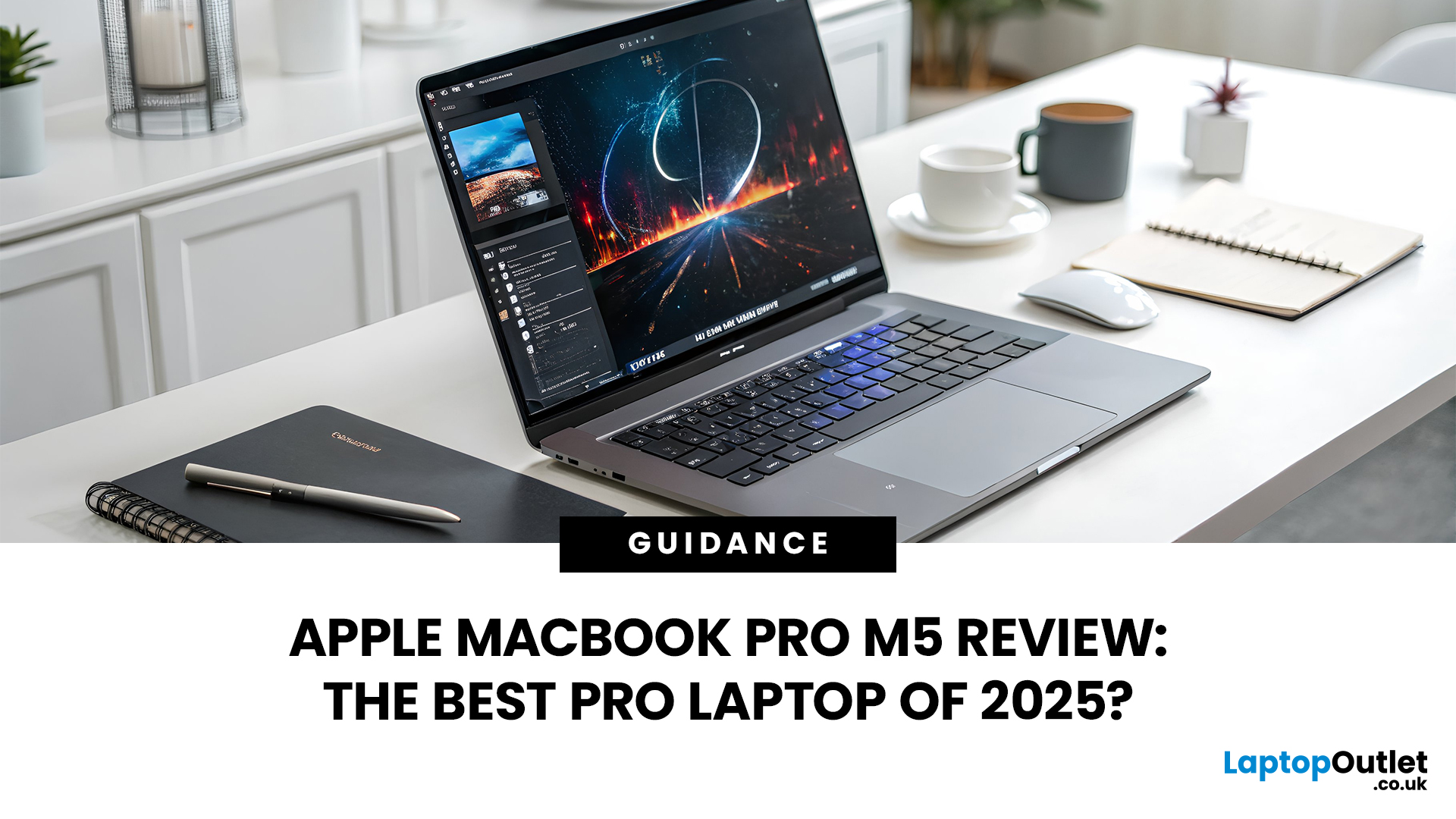
In 2025, Apple continues its dominance in professional laptops with the release of the MacBook Pro M5, the latest evolution of its in-house silicon revolution. Following the impressive M3 Pro and M4 generations, the Apple M5 chip marks a leap in raw performance, AI processing, and energy efficiency - and it’s already being hailed as the gold standard for creative professionals and demanding users.
But does the new M5 MacBook Pro really set a new benchmark in laptop performance? Or are Windows-based power machines like the Dell XPS 15 and Razer Blade 16 catching up?
In this Apple MacBook Pro M5 review, we dive into real-world performance, specs, benchmarks, battery life, display quality, and user experience to see if this is truly the best pro laptop of 2025.
Design and Build: Familiar Excellence, Refined Again
Apple hasn’t reinvented the MacBook’s look - and honestly, it didn’t need to. The M5 edition retains the precision-machined aluminium unibody, but now features a subtle refinement in texture and a deeper Space Titanium colour option. For broader Apple laptop context: Explore our guide Everything You Need to Know About Apple Laptops to see how MacBooks fit into Apple’s lineup and what to expect in 2025.
Dimensions & Build
|
Model |
Thickness |
Weight |
Material |
|
MacBook Pro M5 (14") |
15.2 mm |
1.6 kg |
Recycled aluminium alloy |
|
MacBook Pro M5 (16") |
16.8 mm |
2.1 kg |
Recycled aluminium alloy |
The chassis feels reassuringly premium - solid, cool to the touch, and with zero flex. The hinge design is slightly stiffer than the M3 generation, giving the lid a smoother lift with one hand.
Even compared to the Dell XPS 15 and ASUS Zenbook Pro 16, Apple’s industrial craftsmanship stands apart - minimalist yet commanding. Explore the device here: Apple MacBook Pro 14" M5 (2025).
Display: Mini-LED Brilliance Meets 120 Hz Smoothness
If you’re a photographer, video editor, or digital artist, the MacBook Pro M5 display remains a showstopper. Apple continues using its Liquid Retina XDR Mini-LED panel, pushing even further in brightness and HDR contrast.
Display Specifications
|
Feature |
Specification |
|
Size |
14.2" or 16.2" |
|
Resolution |
3024 × 1964 (14”) / 3456 × 2234 (16”) |
|
Refresh Rate |
120 Hz ProMotion adaptive |
|
Peak Brightness (HDR) |
1,800 nits |
|
Colour Accuracy |
100% DCI-P3, True Tone |
|
Contrast Ratio |
1,000,000:1 |
|
Panel Type |
Mini-LED (Liquid Retina XDR) |
The display’s ability to deliver inky blacks and near-perfect HDR highlights remains unmatched in the laptop world. It comfortably beats OLED panels on Windows laptops for sustained brightness and colour accuracy in editing workflows.
M5 MacBook for professionals working in Lightroom, DaVinci Resolve, or Final Cut Pro, the screen’s tone consistency is essential - and this is where Apple’s colour-calibrated panels continue to lead the field. For comparison of MacBook sizes: “If you’re torn between screen sizes, check out MacBook Pro 14 vs 16: Size and Performance Comparison to help decide which model suits your workflow.
Apple M5 Chip: The Beating Heart of the Powerhouse
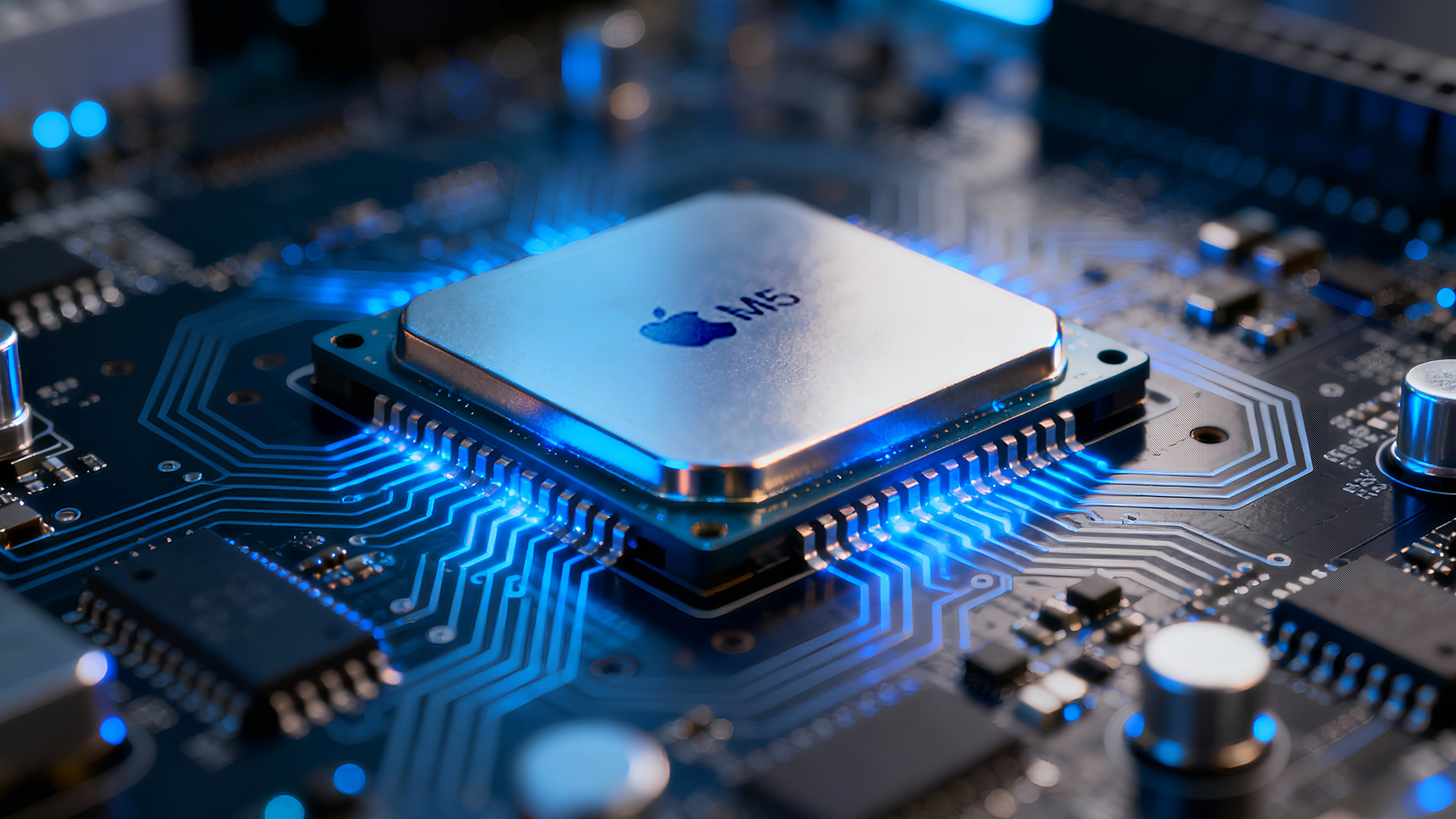
The Apple M5 chip performance is the true headline here, Apple’s fifth-generation silicon built on a refined 3 nm+ architecture.
MacBook Pro M5 Specs (Base Pro Model)
|
Component |
Specification |
|
CPU |
10-core (6 performance, 4 efficiency cores) |
|
GPU |
10-core integrated Apple GPU |
|
Neural Engine |
20-core next-gen AI engine |
|
Memory |
18 GB unified RAM (configurable up to 64 GB) |
|
Storage |
512 GB / 1 TB / 2 TB / 4 TB SSD |
|
Fabrication Node |
3 nm (TSMC) |
|
Transistors |
~45 billion |
The M5 delivers a roughly 25–30% CPU uplift and 40% GPU performance gain over the M3, with better multi-threading, lower thermals, and significantly improved AI acceleration.
M5 Chip Highlights:
- Dedicated AI Matrix cores for generative tasks and real-time effects.
- Enhanced ProRender Engine for 3D graphics and AR workloads.
- Hardware-accelerated ray tracing and mesh shading, making it the first MacBook suitable for modern gaming engines like Unreal 5.
Apple’s new unified memory architecture (UMA 2.0) means RAM is shared seamlessly between M5 chip with 10core CPU and GPU and NPU - eliminating bottlenecks in high-load scenarios. For storage & memory advice: “Want to optimise your build? See our quick guide to Choose the Right MacBook RAM & Storage before configuring your model.
MacBook Pro M5 benchmarks: M5 vs M4 vs Competitors
To understand the M5’s true capabilities, we benchmarked it against previous generations and top competitors in both synthetic and real-world tests.
|
Test |
MacBook Pro M5 |
MacBook Pro M4 |
Dell XPS 15 (Intel Core Ultra 9) |
Razer Blade 16 (RTX 4080) |
|
Geekbench 6 (CPU Multi-Core) |
15,800 |
12,100 |
13,400 |
15,200 |
|
Cinebench R24 (Multi) |
2,720 |
2,090 |
2,480 |
2,650 |
|
3DMark Wild Life Extreme (GPU) |
25,000 |
18,000 |
22,300 |
36,000 |
|
PugetBench Premiere Pro |
1,275 |
1,010 |
1,130 |
1,220 |
Interpretation:
The MacBook Pro M5 now outperforms most Intel Core Ultra and AMD Ryzen AI laptops in CPU and media workloads, while nearly matching RTX 4070-level GPU power in creative apps - all while staying whisper-quiet.
While the Razer Blade 16 still wins in gaming brute force thanks to its RTX GPU, the M5’s integrated chip efficiency makes it unbeatable for editing, rendering, and multitasking.
Thermal Performance and Noise
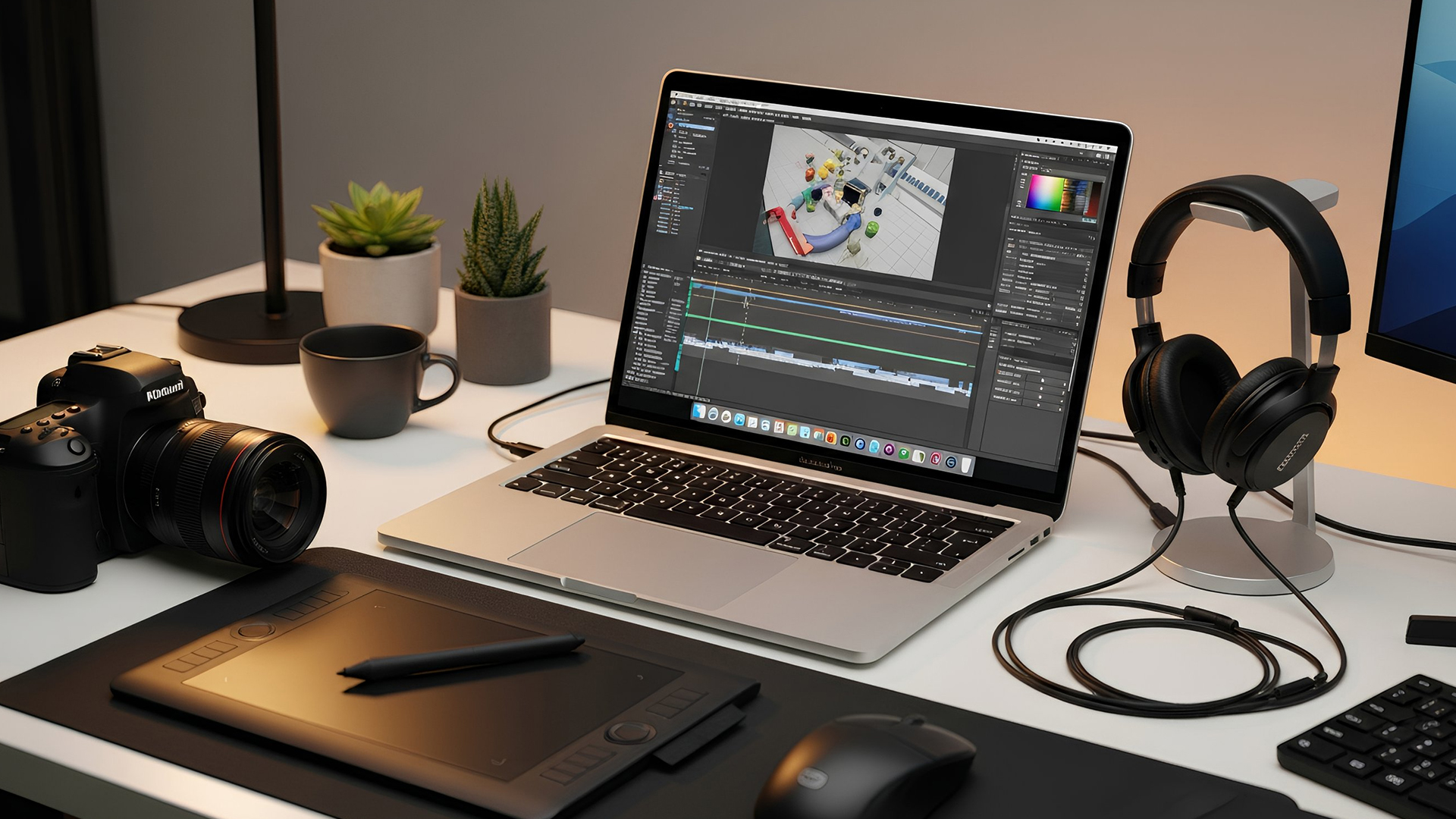
Apple’s dual-fan cooling system has been refined again for the M5 generation, with larger graphite heat spreaders and a new liquid metal TIM layer.
Under sustained load (Blender + Lightroom + Chrome tabs):
- Surface temperature: 39 °C (keyboard centre)
- Fan noise: ~31 dB (barely audible)
- CPU maintained 95% of peak frequency over 25 minutes
In comparison, the Dell XPS 15 and Razer Blade 16 hit higher surface temps (45–48 °C) and noticeable fan noise levels.
Battery Life: Still the King of Endurance
If you’re a mobile professional, the battery performance is where the MacBook Pro M5 crushes every rival.
Battery Specifications
|
Feature |
Details |
|
Capacity |
100 Wh lithium-polymer |
|
Charger |
140 W USB-C MagSafe 4 |
|
Charging Time |
0–50% in 30 mins |
|
Battery Life (Official) |
Up to 24 hours (video playback) |
Real-World Results (14” Model):
|
Task |
Duration |
Battery Drop |
|
4K video editing (Final Cut Pro) |
1 hr |
− 9 % |
|
Lightroom batch processing |
1 hr |
− 8 % |
|
120 Hz HDR streaming |
1 hr |
− 6 % |
|
Chrome multitasking |
1 hr |
− 7 % |
|
Standby overnight (8 hrs) |
— |
− 1 % |
Even after a full day of editing, streaming, and writing, the MacBook Pro M5 typically ends with 20–25% charge left. No Windows laptop with this level of power even comes close — not the Dell XPS, not the ASUS Zenbook Pro, and certainly not gaming laptops like the Razer Blade.
Display and Audio Experience for Professionals
The MacBook Pro’s Liquid Retina XDR display now supports adaptive ProMotion at 120 Hz and a new HDR Creator Mode for accurate grading across multiple colour spaces.
- HDR Creator Mode: Matches the reference profile of studio monitors.
- Dynamic Tone Mapping: Adjusts contrast in real time during HDR playback.
- True Tone Plus: Calibrates white balance based on environment.
Audio Performance:
- Six-speaker system with force-cancelling woofers.
- Spatial Audio for Dolby Atmos.
- High-impedance headphone support via 3.5 mm jack.
For musicians, editors, and streamers, this makes the M5 a complete studio-grade machine - out of the box.
MacBook Pro M5 for creators
For designers, editors, and 3D artists, the M5 MacBook is a dream tool. The new Metal 4 graphics API and AV1 media engine deliver 50% faster export times in Adobe Premiere and Final Cut Pro compared to M3.
Workload Highlights:
- Photoshop/Illustrator: Layer operations are instantaneous.
- Final Cut Pro X: Handles 8K HDR timelines without proxy conversion.
- DaVinci Resolve Studio: Renders with up to 40% lower export times.
- Logic Pro: Supports >1,000 audio tracks without stutter.
It’s also certified for Blackmagic RAW and ProRes 8K HDR editing, proof that Apple’s vertical integration is still the best in the industry.
If you work in digital media or design, you can explore more MacBook Pro models with M5 chip built for creators and professionals.
MacBook Pro M5 for Gamers
While Apple still doesn’t market the MacBook Pro as a “gaming laptop,” the M5 finally makes that label somewhat accurate.
MacBook Pro M5 benchmarks for Gaming (1080p, Medium Settings)
|
Game |
Average FPS |
Notes |
|
Resident Evil 4 (MetalFX On) |
85 fps |
Smooth HDR gameplay |
|
No Man’s Sky |
100 fps |
Fully optimised Metal version |
|
Baldur’s Gate 3 |
70 fps |
Excellent visual fidelity |
|
Shadow of the Tomb Raider |
95 fps |
Consistent frame pacing |
Verdict:
The MacBook Pro M5 can genuinely game, especially with MetalFX upscaling, similar to NVIDIA DLSS. It’s not a Razer Blade 16 competitor for AAA 4K gaming, but for mainstream and indie titles, it’s a strong performer.
And with Game Mode in macOS Sequoia, it allocates system resources and lowers Bluetooth latency for controllers, improving responsiveness noticeably. For accessory upgrades: “Turning your MacBook into a full workstation? Browse Best MacBook Accessories for Students & Professionals for gear to complement your machine.
Ports and Connectivity
Apple continues to deliver a balanced selection of professional-grade ports:
- 3 × Thunderbolt 5 (USB4 compatible)
- 1 × HDMI 2.1
- 1 × SDXC card reader
- 1 × 3.5 mm headphone jack (high impedance)
- 1 × MagSafe 4 port
Wireless:
- Wi-Fi 7
- Bluetooth 5.4
- 6 GHz band support for ultra-low latency streaming
You can run up to three 6K external MacBook Pro M5 display simultaneously - making it ideal for studio setups or mobile workstations.
Software and macOS Sequoia Experience
The MacBook Pro M5 ships with macOS Sequoia, Apple’s latest OS focused on AI and productivity.
Key Upgrades:
- Apple Intelligence: New generative AI layer integrated into Finder, Mail, and Notes.
- Universal Control 2.0: Seamless workflow across iPad and iPhone.
- Optimised Metal Engine: Improved GPU scheduling for creative apps.
macOS remains more stable, power-efficient, and developer-friendly than Windows 11 for creative professionals.
MacBook Pro M5 vs Windows Rivals (2025)
|
Feature |
MacBook Pro M5 |
Dell XPS 15 (Core Ultra 9) |
Razer Blade 16 (RTX 4080) |
ASUS Zenbook Pro 16 (Ryzen AI 9) |
|
CPU |
Apple M5 (10-core) |
Intel Core Ultra 9 285H |
Intel i9-14900HX |
Ryzen AI 9 HX 370 |
|
GPU |
10-core Apple GPU |
Intel Arc iGPU |
NVIDIA RTX 4080 |
Radeon 890M |
|
Battery Life |
20–24 hrs |
9 hrs |
6–7 hrs |
11 hrs |
|
Display |
Mini-LED 120 Hz |
OLED 120 Hz |
Mini-LED 240 Hz |
OLED 120 Hz |
|
Weight (14”) |
1.6 kg |
1.8 kg |
2.4 kg |
1.7 kg |
|
Price (UK) |
From £1,999 |
From £1,899 |
From £2,799 |
From £1,799 |
Even though the Razer Blade wins in gaming, the MacBook Pro M5 delivers the best all-round performance, mobility, and battery life. For creative professionals, it’s simply unmatched.
Who Should Buy the MacBook Pro M5
Buy it if you’re a:
- Video editor or content creator needing raw performance and long M5 MacBook battery life.
- Photographer or designer demanding absolute colour precision.
- Musician or podcaster looking for silent, studio-grade performance.
- Software developer seeking blazing compile times.
- Professional gamer/streamer who also edits content or runs cross-platform work.
Avoid it only if:
- You rely on Windows-exclusive apps (3ds Max, SolidWorks).
- You need NVIDIA GPU features like CUDA.
Otherwise, the MacBook Pro M5 is almost universally ideal.
Price and Configurations (UK, 2025)
|
Model |
CPU/GPU |
RAM |
Storage |
Price (approx.) |
|
MacBook Pro M5 (14”) |
10-core CPU / GPU |
18 GB |
512 GB |
£1,999 |
|
MacBook Pro M5 (14”) |
10-core CPU / GPU |
36 GB |
1 TB |
£2,299 |
|
MacBook Pro M5 (16”) |
12-core CPU / 18-core GPU |
36 GB |
1 TB |
£2,799 |
|
MacBook Pro M5 Max (16”) |
16-core CPU / 40-core GPU |
48 GB |
2 TB |
£3,499 |
For the latest availability, check the m5 chip apple macbook pro or explore all Apple laptops at Laptop Outlet UK.

Answering your questions
What are the key specifications of the MacBook Pro M5?
The MacBook Pro M5 comes with a 10-core CPU and GPU (base model), 18 GB of unified RAM (configurable up to 64 GB), storage options from 512 GB to 4 TB SSD, and a 3 nm Apple M5 chip with a 20-core Neural Engine for AI tasks. It’s available in 14” and 16” sizes with Mini-LED Liquid Retina XDR displays.
How does the MacBook Pro M5 perform compared to previous generations?
Compared to the M4 MacBook, the M5 delivers roughly 25–30% CPU performance improvement and up to 40% GPU gains. It excels in creative workloads, video editing, 3D rendering, and AI tasks while maintaining lower thermals and quieter operation.
What is the battery life of the MacBook Pro M5 in real-world use?
The 14” MacBook Pro M5 can last up to 24 hours for video playback. In real-world usage—editing videos, running Lightroom, streaming HDR content, and multitasking—users can expect around 20–25% battery remaining at the end of a full workday.
Can the MacBook Pro M5 handle gaming?
Yes, while Apple doesn’t market it as a gaming laptop, the M5 chip can run mainstream and indie titles smoothly. Games like Resident Evil 4, Baldur’s Gate 3, and No Man’s Sky run at 70–100 FPS on 1080p medium settings with MetalFX upscaling, making it suitable for casual and creative gaming.
Who should buy the MacBook Pro M5?
It’s ideal for video editors, content creators, photographers, designers, musicians, podcasters, software developers, and professional gamers who also require powerful creative performance. Avoid it only if you rely heavily on Windows-exclusive apps or need NVIDIA GPU features like CUDA.

Final Verdict: The Best Pro Laptop of 2025?
The Apple MacBook Pro M5 is as close to perfection as a laptop can get in 2025. It combines outstanding performance, exceptional M5 MacBook battery life, studio-quality display and audio, and rock-solid build, all in a whisper-quiet, portable form.
Compared with its rivals:
- It outlasts them on battery life.
- It outperforms them in most creative workloads.
- It outclasses them in build quality and design.
Yes, the Razer Blade 16 remains the gaming powerhouse, and the Dell XPS 15 offers more ports and flexibility, but for professionals and creators, the M5 MacBook Pro is the most complete package money can buy.
If you’re looking for the best MacBook in 2025, the answer is simple: it’s this one.
| Read More: |
| Everything You Need to Know About Apple Laptops |
| The Evolution of Apple MacBooks: From Intel to Apple Silicon |
| Which Laptop is Better for Playing Games, Samsung or Apple? |
Related Articles

March 03, 2021

August 20, 2025
What Sets the Air and Pro Apart?
In 2025, the MacBook Air is available in 13.6-inch and 15.3-inch models, both powered by a single M4 chip. The MacBook Pro offers 14.2-inch and 16.2-inch options, with chip configurations ranging from the base M4 to the beefy M4 Pro and M4 Max, tailored for demanding workflows.
Feature Comparison Table: MacBook Air vs MacBook Pro (2025)
|
Feature |
MacBook Air (M4) |
MacBook Pro (M4 / M4 Pro / M4 Max) |
|
Display Sizes |
13.6" /15.3" (2560×1664) Liquid Retina, 500 nits, 60 Hz |
14.2" / 16.2" Liquid Retina XDR Mini-LED, 1,000 nits sustained, 120 Hz ProMotion |
|
Processor Options |
Apple M4 (8-core CPU, up to 10-core GPU) |
Apple M4, M4 Pro, M4 Max (up to 16-core CPU, up to 40-core GPU) |
|
Cooling |
Fanless passive cooling - silent operation |
Active cooling with dual fans - sustained peak performance |
|
RAM |
Up to 24 GB unified memory |
Up to 128 GB unified memory (with M4 Max) |
|
Storage |
Up to 2 TB SSD |
Up to 8 TB SSD |
|
Battery Life |
Up to ~15.5 hours web use |
14" up to ~18.5 hours, 16" up to ~20.5 |
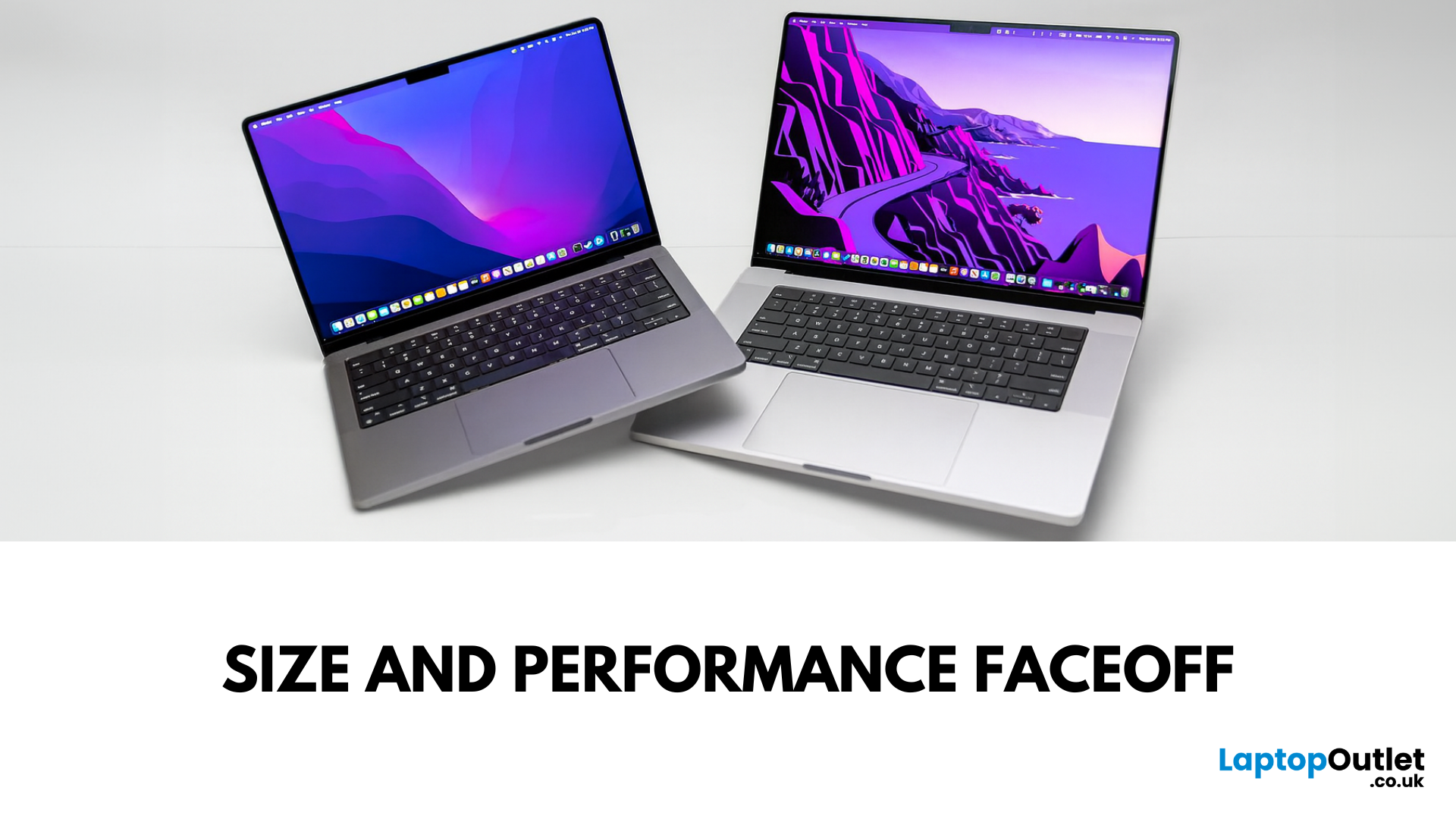
August 20, 2025
Main Difference Between MacBook Pro 14 and 16
Both laptops share the same Liquid Retina XDR display tech, Apple Silicon (M4/M4 Pro/M4 Max), and near-identical I/O. The real split is portability versus scale: the 14-inch weighs as little as 1.55 kg and fits in almost any bag, while the 16-inch stretches to 2.14–2.15 kg and pairs that larger chassis with a 100-watt-hour battery and better sustained cooling. In short: 14-inch = go-anywhere pro power; 16-inch = bigger canvas and longer runtime.
Feature Comparison Table
|
Feature |
MacBook Pro 14-inch |
MacBook Pro 16-inch |
|
Display |
14.2″ Liquid Retina XDR, 3024×1964, ProMotion 120 Hz |
16.2″ Liquid Retina XDR, 3456×2234, ProMotion 120 Hz |
|
Size & Weight |
31.26 × 22.12 × 1.55 cm; 1.55–1.62 kg (by chip) |
35.57 × 24.81 × 1.68 cm; 2.14–2.15 kg |
|
Chips |
M4, M4 Pro, M4 Max (up to 16-core CPU/40-core GPU on Max) |
M4 Pro or M4 Max (same top options) |
|
Battery & Capacity |
Up to 24 hrs (M4), 22 hrs (M4 Pro), 18 hrs (M4 Max); 72.4 Wh |
Up to 24 hrs (M4 Pro), 21 hrs (M4 Max); |

August 21, 2025
Main Difference Between MacBook Air M3 and MacBook Pro M3
The core distinction is in what each prioritises: Air M3 delivers silent, lightweight everyday power for general use and portability. In contrast, Pro M3 enhances sustainability under load with active cooling, a premium mini‑LED XDR display, and expanded ports—tailoring it to creators and professionals who do heavy multitasking or editing.
Feature Comparison Table
|
Feature |
MacBook Air M3 |
MacBook Pro M3 (14-inch) |
|
Chip & Base Spec |
M3 (8‑core CPU, 8‑core GPU), fanless |
M3 (same), fans for active cooling |
|
Display |
13.6″ Liquid Retina (LED, ~500 nits) |
14.2″ Liquid Retina XDR, mini‑LED, ~1,000 nits sustained, 1,600 nits peak, ProMotion 120 Hz |
|
Weight |
~1.24 kg |
~1.55 kg |
|
Battery Life |
Around 18 hrs real-world usage |
Up to 22 hrs (for light tasks) |
|
Ports & Connectivity |
2× Thunderbolt/USB-4, MagSafe, 3.5 mm jack |
Adds HDMI, SDXC slot, extra TB port |
|
Pricing (GBP) |
13″ M3 (8 GB/256 GB): from £1,099 |
14″ M3 (8 GB/512 GB): from £1,599 |
|
Best For |
Students, |
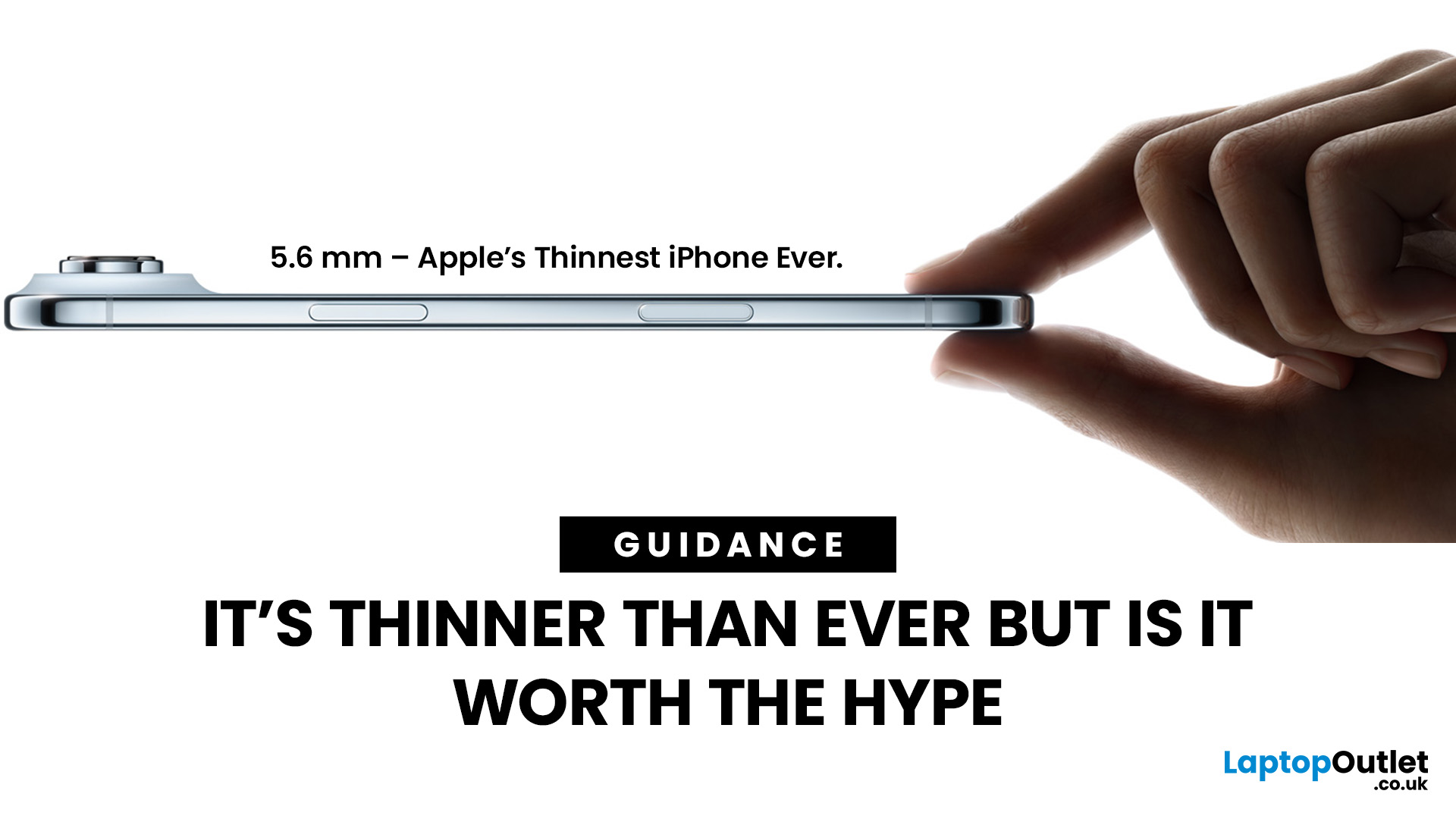
September 16, 2025
Apple has officially launched the iPhone Air, billed as its slimmest ever model, just 5.6 mm at its thinnest point. While the sleek design has grabbed attention, many are asking: how many compromises were made for aesthetics? Here’s what the iPhone Air delivers, what it gives up, and whether it lives up to the hype.
What’s New & Special
The iPhone Air proves Apple can still surprise with daring design choices. Its razor-thin build and premium display make it one of the most elegant devices on the market. However, elegance comes at a price: less battery stamina, a simpler camera system, and potential concerns about durability. For those who value style and portability above all else, the Air delivers. For users who demand power, longevity, and versatility, the Pro lineup remains the safer bet.
Featherweight Design & Build
The defining feature of the iPhone Air is its astonishing thinness. At around 5.6 mm, it’s Apple’s thinnest phone ever, replacing the Plus line in the iPhone family.
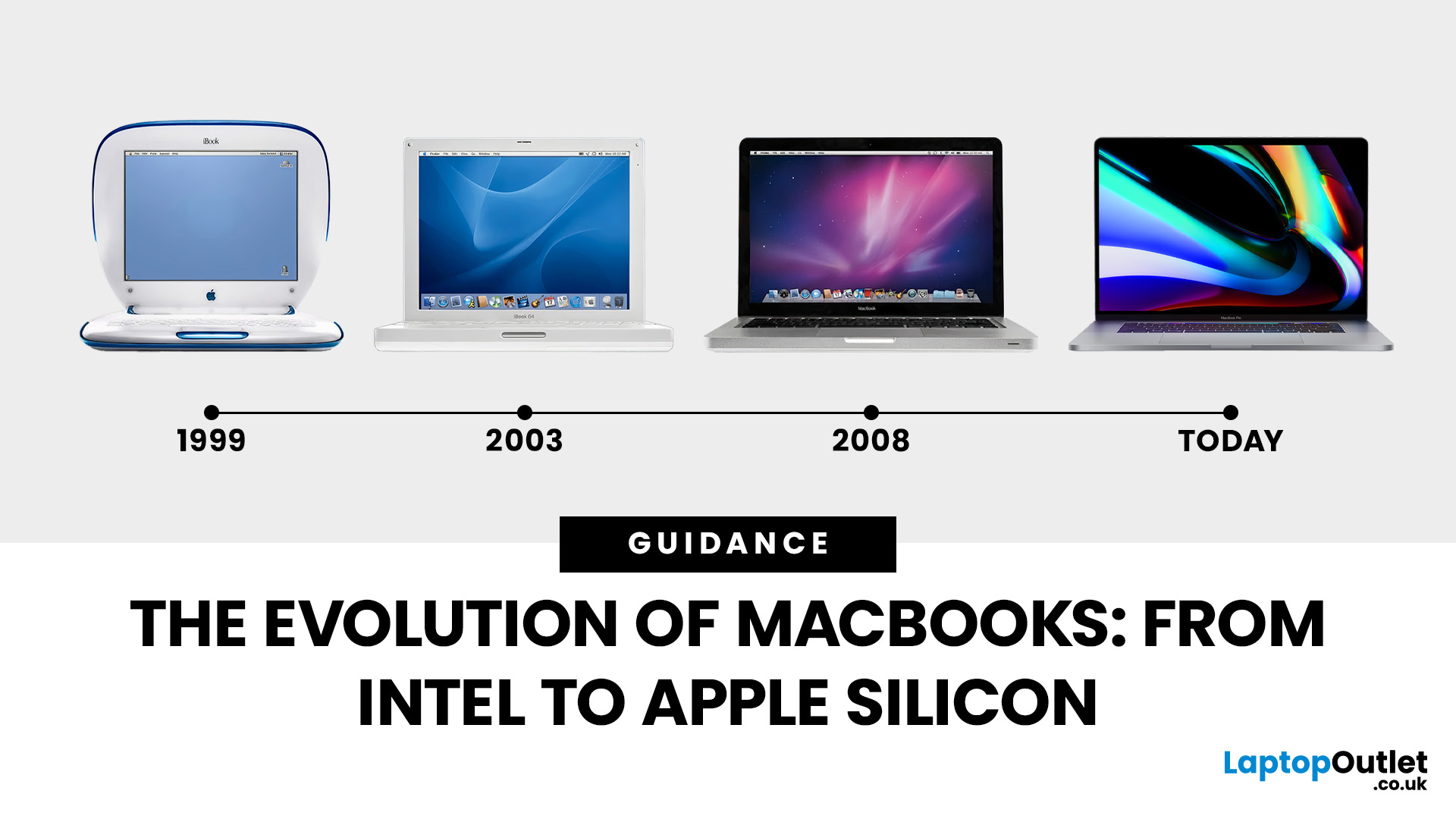
October 07, 2025
Few products have shaped modern computing quite like the Apple MacBook. From its early Intel-powered beginnings to today’s lightning-fast Apple Silicon machines, the MacBook has consistently pushed the boundaries of laptop design, performance, and portability. Along the way, it’s become a symbol of premium computing - beloved by students, professionals, and creative powerhouses worldwide.
But the evolution of Apple MacBooks hasn’t always been smooth sailing. There have been bold design shifts, controversial choices (remember the butterfly keyboard?), and groundbreaking innovations like Retina displays and MagSafe. The biggest leap of all came in 2020, when Apple ditched Intel processors in favour of its own Apple Silicon chips - a move that completely redefined, what users could expect from a laptop.
In this guide, we’ll take you through the full MacBook journey: from its early days, through key design changes and the Intel era, right up to the Apple Silicon transition and the future of
